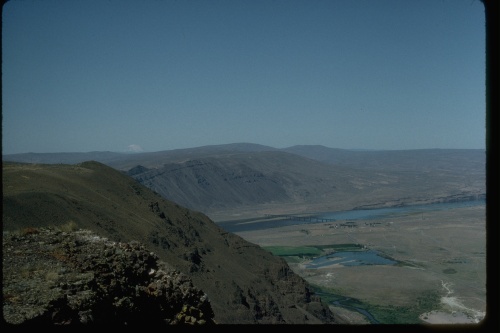
News of the wreck was suppressed. It is not known how many GIs lost their lives when this troop train derailed.
World War II brought many changes to the bucolic way of life people were used to living in Eastern Washington. A huge chunk of sandy real estate south of Saddle Mountain had been condemned and occupied by the government, and nobody knew what they were doing there–and if you got too nosy, they’d shoot at you. On the north side of the mountain, the Yakima Firing Range had been extended into the Lower Crab Creek valley. Fighter and bomber pilots flew missions in the skies above the canyons and scablands that used to stand silent in the blistering heat.
Yet below the mock combat, farmers and ranchers continued to plant crops and herd livestock to feed the country. Oscar Danielson died early in the war, leaving the running of his Crab Creek ranch to his eldest son, Walter. Because he had a job farming, Walter was excused from serving in the armed forces. Not so the next younger sons.
George, the second son, joined the Army and received training as an engineer. His unit was shipped off to North Africa in 1942. Years later, George would tell me that he had “passed through Kasserine Pass about an hour before Rommel took it.” A year or so ago I read Rick Atkinson’s book about Americans in North Africa, An Army at Dawn. In it, I learned that the engineers had been left to defend Kasserine Pass against Rommels Panzerkorps. My uncle was too modest to admit the role he had played in buying extra time for the American retreat through Kasserine Pass.
Lawrence, the third son, also served in the Army in Europe in World War II. His stories I never heard, and indeed, his own family heard little about what he witnessed in Italy until very late in his life. War is hell, so they say.
Even the only daughter, fourth child in the family, was fated to marry a man who served as a Chief Petty Officer in the Navy during the war. But somehow, they all came home alive and whole.
My father told me once about the problem Crab Creek ranchers had with the flyers during the war. Bomber pilots trained with dummy bombs–casings filled with powder (flour, most often) so that their strikes could be noted from the air. But the fighter pilots used live fifty-caliber ammunition, interlaced with tracers so that they could see what they hit. Some of the pilots used to strafe cattle along the creek. Ranchers, howling their protests at Moses Lake Army Air Base in Moses Lake (later, Larson Air Force Base), were told that the pilots would be disciplined as soon as their plane’s tail number was reported. Of course, by the time ranchers Continue reading →




